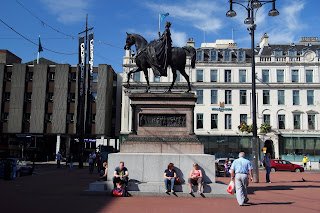My dad decided to dig out an old circular polarising filter the other day, and I took the liberty of taking it out into town for a spin. CPFs are incredibly useful devices for doing a number of things: darkening the sky, making foliage more dramatic, getting rid of glare, making water transparent, and just generally giving the scenes fuller colour and contrast.
How they work is pretty simple: think of it as a sheet of Venetian blinds that you can rotate longitudinally. It is able to take a block of unpolarised light and transform it into parallel "sheets" (or more correctly waves) of polarised light. With an already polarised light source it will reduce the intensity of the light, or completely block the light altogether - this is why you can sometimes make your LCD screen look "switched off" with one of these filters.
| Fig 1. How circular polarising filters work |
Many non-metallic surfaces reflect only polarised light when shone upon - tarmac, lakes, water droplets in the sky and so on. By removing these reflections you can produce quite neat effects: the sky looks a lot darker, the tarmac less reflective, the water see through! It also makes vegetation look nicer because the water residue on the leaves reflects (polarised) light.
The result? Increased colour and contrast!
Good, isn't it? They come in many filter sizes, and generally cater for Bridge/DSLRs. If you have neither of those things, you can just use a square filter or even polarising sunglasses if you so wish.
All in the name of taking nicer and nicer pictures of my home town!






No comments:
Post a Comment